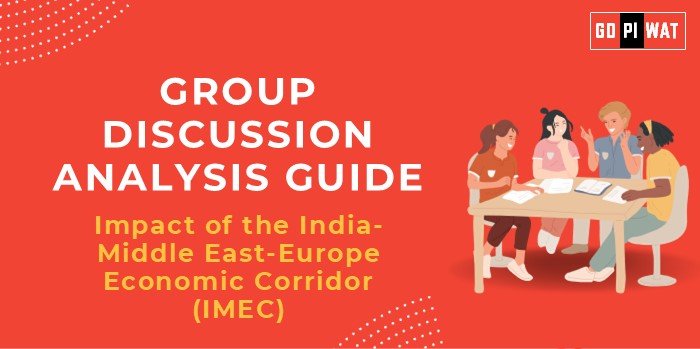📋 Impact of the India-Middle East-Europe Economic Corridor (IMEC)
🌐 Introduction to IMEC
The India-Middle East-Europe Economic Corridor (IMEC) is an ambitious multi-national trade corridor announced in 2023, aimed at enhancing trade, economic cooperation, and connectivity between India, the Middle East, and Europe. This project is poised to reshape global trade patterns and bolster regional economic integration.
📖 Opening Context
IMEC was introduced at the G20 Summit in September 2023 as a collaborative initiative between countries such as India, the UAE, Saudi Arabia, and the European Union. The corridor aims to provide a modern and efficient trade route that strengthens connectivity between Asia, the Middle East, and Europe via railways, ports, and digital networks, offering a strategic counterbalance to China’s Belt and Road Initiative (BRI).
📊 Quick Facts and Key Statistics
- 🗓️ Launch Date: September 9, 2023, during the G20 Summit in New Delhi.
- 🌍 Participating Entities: India, United States, United Arab Emirates, Saudi Arabia, France, Germany, Italy, Jordan, and the European Union.
- 🚂 Core Components: Development of railways, ports, and digital connectivity to streamline trade routes.
🤝 Stakeholders and Their Roles
- India: Aims to enhance trade connectivity and economic growth by serving as a pivotal link between Asia and Europe.
- Middle Eastern Countries (UAE, Saudi Arabia): Seek to diversify their economies and establish themselves as central hubs in global trade networks.
- European Union: Intends to strengthen trade routes and reduce dependency on existing supply chains.
- United States: Supports the initiative as a strategic counterbalance to China’s Belt and Road Initiative (BRI).
- Private Sector: Expected to play a significant role in financing and executing infrastructure projects.
🏆 Achievements and ⚠️ Challenges
Achievements:
- 🤝 Strategic Collaboration: The signing of the Memorandum of Understanding (MoU) by multiple nations signifies a unified approach to enhancing global trade connectivity.
- 🚧 Infrastructure Development: Plans for developing railways and ports are set to reduce transit times and costs, boosting trade efficiency.
Challenges:
- ⚔️ Geopolitical Tensions: Ongoing conflicts in the Middle East, such as the Israel-Hamas war, may delay project implementation.
- 💸 Funding and Coordination: The scale of the project requires substantial investment and coordination among diverse stakeholders.
- 🛠️ Infrastructure Gaps: Existing infrastructure may need significant upgrades to meet the corridor’s requirements.
🌍 Global Comparisons
IMEC is frequently compared to other large-scale trade and infrastructure initiatives, offering insights and lessons on global connectivity:
- China’s Belt and Road Initiative (BRI): IMEC is viewed as a strategic alternative to the BRI, aiming to offer diversified trade routes and reduce reliance on existing channels.
- Trans-European Transport Network (TEN-T): The European Union’s TEN-T project provides insights into large-scale, cross-border infrastructure initiatives.
📚 Case Studies
- India’s Sagarmala Project: Focuses on port-led development to enhance logistics and trade, aligning with IMEC’s objectives.
- EU’s TEN-T: Aims to improve transport infrastructure across Europe, offering lessons in managing multinational infrastructure projects.
💬 Structured Arguments for Discussion
Consider these viewpoints for a balanced group discussion:
- Supporting Stance: “IMEC represents a transformative initiative that will enhance global trade connectivity, reduce transit times, and foster economic growth across participating regions.”
- Opposing Stance: “The success of IMEC is uncertain due to potential geopolitical conflicts, funding challenges, and the complexity of coordinating among diverse nations.”
- Balanced Perspective: “While IMEC holds significant promise for enhancing global trade, its success will depend on effective collaboration, stable geopolitical conditions, and robust infrastructure development.”
🎯 Effective Discussion Approaches
- Opening Approaches:
- 🌏 Historical Context: “Drawing parallels to the ancient Silk Road, IMEC aims to revive and modernize trade routes connecting Asia, the Middle East, and Europe.”
- 💸 Economic Impact: “With the potential to significantly boost GDP across participating nations, IMEC stands as a landmark initiative in global trade.”
- Counter-Argument Handling: “While geopolitical tensions pose challenges, the collaborative framework of IMEC includes mechanisms for conflict resolution and risk mitigation.”
🔍 Strategic Analysis of Strengths and Weaknesses
Strengths:
- 📈 Enhanced trade connectivity between Asia, the Middle East, and Europe.
- 📊 Diversification of trade routes, reducing dependency on existing channels.
- 💼 Potential economic growth and job creation in participating regions.
Weaknesses:
- ⚔️ Geopolitical instability in certain regions may disrupt progress.
- 💰 High capital investment required for infrastructure development.
- 🤝 Complex coordination needed among diverse stakeholders.
Opportunities:
- 🤝 Strengthening regional cooperation and economic integration.
- 🚀 Development of modern infrastructure, including digital connectivity.
- 🌍 Positioning participating countries as central hubs in global trade.
Threats:
- ⏱️ Potential delays due to political conflicts or economic downturns.
- ⚖️ Competition from other major trade initiatives like China’s BRI.
- 🌿 Environmental concerns related to large-scale infrastructure projects.
📚 Connecting with B-School Applications
IMEC offers practical insights relevant to B-School projects, case studies, and applications:
- Real-World Applications: IMEC offers case studies in international trade, infrastructure development, and strategic management, relevant for projects in logistics, supply chain management, and international business.
- Sample Interview Questions:
- ❓ “How can IMEC influence global supply chain dynamics?”
- ❓ “Discuss the potential economic impacts of IMEC on participating countries.”
- Insights for B-School Students: Understanding IMEC provides insights into multinational project management, the complexities of international collaboration, and the strategic considerations in large-scale infrastructure initiatives.


